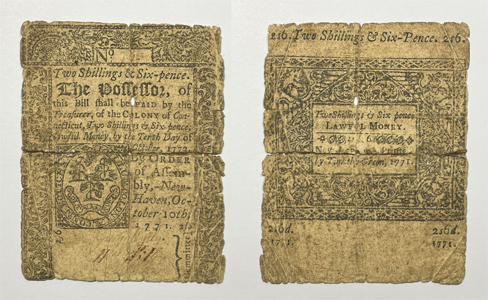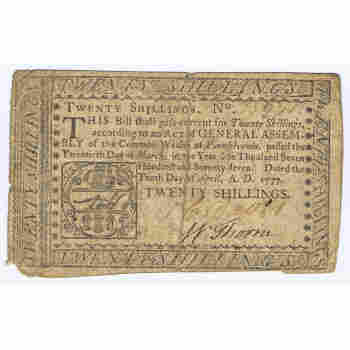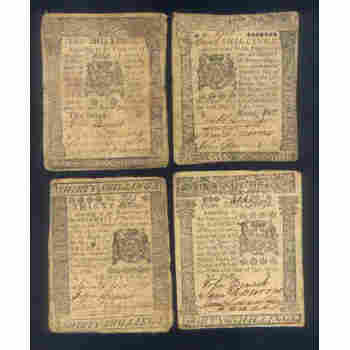Here is some information about several of the notables whose names appear on these Connecticut Bills of Credit, including; Jabez Hamlin, Joseph Hopkins, Thomas Mumford, Jesse Root, Thomas Seymour etc.
/////////////////////////////////
Thomas Mumford (1728–1799), a merchant in Groton, CT, contracted with the Secret Committee of Congress on 28 November 1775 to import a large quantity of gunpowder for use of the Continental Army and Navy. To meet General george Washington’s immediate needs, Governor Trumbull agreed to loan him 8,640 pounds of gunpowder from the Connecticut stocks in Norwich and Providence with the understanding that it would be replaced when the Continental supplies arrived. About 17 April two of Mumford’s vessels landed cargoes of gunpowder, sulfur, and salt at Norwich, and in July the Secret Committee directed Mumford to reimburse Connecticut for its gunpowder from those cargoes.
Mumford in 1780 sent General Washington a barrel of about 125 gallons of Madeira wine that one of his privateers had captured from the British.
Thomas Mumford received a letter from General George Washington on 13 February 1776 asking for gun powder….
Obliges me to Send Colonel Gay*, to borrow, or purchass as much, as he Can possibly procure, I beg Sir that you will give him every Assistance in Your power, in negotiating this Important business—it will be of the utmost Service to the Cause of Liberty & America, & it will very Much oblige Sir Your …
*Fisher Gay (1732–1776) was a merchant from Farmington, CT and a lieutenant colonel of one of the three regiments of Connecticut militia, that had reinforced the Continental Army. In June 1776 he was made colonel of a militia regiment sent to aid the Continental army at New York. Gay died on 27 September 1776.
///////////////////////////
Jesse Root (December 28, 1736 – March 29, 1822) was an American minister and lawyer from Coventry, Connecticut. During the Revolution he served on the Connecticut Council of Safety and in the Connecticut militia. Originally appointed as a Lieutenant Colonel in Peekskill in 1777, he rose to the rank of Adjustant-General of the Connecticut Line. He was a delegate to the Continental Congress for Connecticut from 1778 until 1782, and sat as chief justice of the state’s Supreme Court from 1796 to 1807 as well as a state court judge. He served in the Connecticut House of Representatives and served in the Connecticut Constitutional Convention. He was also a member of the First Company, Governor’s Foot Guard, serving as its commandant between May 1798-October 1802.
//////////////////////////////////////////////////////////
Joseph Hopkins (1730-1801) began as a silversmith and watchmaker, but later pursued a legal career, becoming Justice of the Peace in 1762. He was elected to the General Assembly 45 times, beginning in 1764; and he was the first judge of probate for Waterbury. By the Revolutionary War, Hopkins was considered to be the most prominent citizen in Waterbury and dined with George Washington and the Marquis de Lafayette when they came during the war.
Hopkins owned one slave, named ‘Silence Will’ whom he purchased in the 1760s. He was also the executor of Cuff Capeny’s will a free African American who served gallantly during the Revolutionary War. In his will, dated 1777, Capeny* left money for Silence, servant of Joseph Hopkins and she was freed by Hopkinns in 1798.
Hopkins died 3 years later while in New Haven as senior assistant judge of the county court.
*The American Revolution was not strongly supported by whites, and the leaders found it difficult to recruit many to fight for their cause. As such and because there was no thought that Blacks were inferior, the white ruling class recruited African-Americans to fight for their cause
////////////////////////////////
Jabez Hamlin was a colonel in the Connecticut militia (as of 1771) having served served as both a commissary with the rank of major and as a lieutenant colonel of militia during the French and Indian War. He was also an appointed judge of the Hartford County Court (1754-1784), judge of probate (1752-1789) and mayor of the City of Middletown (1784- 1791). He was elected to the Connecticut General Assembly from 1758-1767. And member of a committee on Pequot Indians in 1760 and of the Mohegan Indians in 1773.
//////////////////////////////////
Thomas Seymour (1735-1829) was a central figure in Hartford, Connecticut during his lifetime. After graduating from Yale (as most of the other notables did as well), he served s the King’s Attorney in 1767, and after the Revolution, as the State’s Attorney. During the Revolution he was commissioned a Captain of Militia in 1773, promoted to Liutenant in 1774, and led three regiments of light horse cavalry to aid the Continental Army in New York during the summer of 1776. Seymour also served as Head of the Committee of Pay Table. He was the first Mayor of Hartford, serving from 1774-1812, also being Speaker of the House in 1790-92, and served as Chief Judge of the Hartford County Court.
/////////////////////////
George Wyllys served as the Secretary of the State of Connecticut during Revolution (took over for father, in 1735 until death in 1796), he was the father of Col. Samuel Wyllys in the Connecticut Line (Who later became 3rd consecutive Wyllys as Sec State of Conn. 1796-1810). His whole family buried in Hartford’s Ancient Burying Ground in unmarked graves because “if Connecticut could not remember the Wyllyses without monuments, their memory might rot.”
////////
Elisha Williams 1718-1784 – Graduated Yale in 1735, he was the son of Rev. Elisha Williams, Served as the Wethersfield representative to the Connecticut General Assembly from 1757-1777 and was appointed as a Colonel of the militia.
////////
Charles Phelps – Sent his slave named Cesar, bought from William Williams to fight in his place in the Revolution, Cesar fought in Ticonderoga – Unknown if he was freed or died.
////////
John Chester (1749–1809) was a militia officer and public official from Connecticut. Before the American Revolution, he was a militia officer and member of the Connecticut General Assembly. During the American Revolutionary War, he saw action from the Battle of Bunker Hill to the Battle of Trenton as part of Connecticut’s troops, but he did not join the Continental Army, and left military service after 1776. He served as Speaker of the Connecticut House of Representatives, among other public offices, and was an original member of the Society of the Cincinnati. His grandson Samuel Chester Reid served in the United States Navy during the War of 1812.
////////
This is an overall list in the dropdown, availability subject to change.
10/10/71 – 2 Shs & 6 P – G. Wyllys & W. Pitkin |
10/10/71 – 5 Shs |
6/1/73 – 5 Shs plain backed – G. Wyllys & E. Williams |
6/1/73 – 5 Shs written backed – B. Payne & E. Williams |
6/1/73 – 5 Shs not backed – G. Wyllys & E. Williams |
6/1/73 – 5 Shs not backed – G. Wyllys & W. Pitkin |
1/2/75 – 2 Shs & 6 P |
1/2/75 – 5 Shs – E. Williams & W. Pitkin & G. Wyllys |
1/2/75 – 5 Shs – T. Seymour & E. Williams & G. Wyllys |
5/10/75 – 2 Shs & 6 P |
5/10/75 – 40 Shs – William Pitkin |
6/1/75 – 1 Sh & 3P |
6/1/75 – 2 Shs & 6P – Reg’d Back |
6/1/75 – 2 Shs & 6P – Reg’d Back |
6/1/75 – 2 Shs & 6P – Reg’d Back |
6/1/75 – 2 Shs & 6P – Not Backed |
6/1/75 – 6 Shs |
7/1/75 – 2 Shs & 6P – Reg’d Back |
7/1/75 – 2 Shs & 6P – News Back – G. Wyllys |
7/1/75 – 2 Shs & 6P – Not Backed |
7/1/75 – 2 Shs & 6P-Not Backed – E. Williams & J. Hamlin & J. Root |
7/1/75 – 6 Shs-Backed – J. Root & E. Williams & J. Hamlin |
7/1/75 – 6 Shs – T. Seymour & B. Payne & G. Wyllys |
7/1/75 – 10 Shs – G. Wyllys & T. Seymour & B. Payne |
6/19/75 – 1 Sh-News Back – T. Seymour |
6/19/75 – 1 Sh & 3P-Backed – G. Wyllys |
6/19/75 – 1 Sh & 3P-Not Backed – E. Williams |
6/19/75 – 1 Sh & 6P – G. Wyllys |
6/19/75 – 1 Sh & 6P – B. Payne |
6/19/75 – 2 Shs – News Back |
6/19/75 – 2 Shs – Not Backed |
6/19/75 – 2 Shs – Not Backed |
6/19/75 – 2 Shs & 6P-Backed – E. Williams |
6/19/75 – 3 Shs – Part Backed – J. Root |
6/19/75 – 5 Shs – News backed |
10/11/77 – 3P – Slashed |
10/11/77 – 3P – |
10/11/77 – 4P – T. Mumford |
10/11/77 – 4P – J. Hopkins |
10/11/77 – 4P – |
10/11/77 – 5P – T. Mumford |
10/11/77 – 5P – |
10/11/77 – 7P – T. Mumford |
10/11/77 – 7P – C. Phelps |
3/1/80 – 1 Sh & 3P (weak S & E) |
3/1/80 – 2 Shs & 6P-#1335 |
3/1/80 – 40 Shs – B. Payne & G. Wyllys |
3/1/80 – 40 Shs – |
6/1/80 – 1 Sh & 3P |
6/1/80 – 1 Sh 3P – E. Williams & J. Hamlin |
6/1/80 – 2 Shs & 6P – |
6/1/80 – 40 Shs – E. Williams & J. Hamlin |
7/1/80 – 1 Sh – |
7/1/80 – 1 Sh – |
7/1/80 – 9 Pence – E. Williams & J. Hamlin |
7/1/80 – 9 Pence – J. Hamlin & E. Williams |
7/1/80 – 9 Pence – |
7/1/80 – 9 Pence – Uncancelled – J. Hamlin |
7/1/80 – 5 Shs – |
7/1/80 – 10 Shs – J. Chester & __ |
7/1/80 – 20 Shs – E. Williams & J. Hamlin #18440 |
7/1/80 – 20 Shs – E. Williams & J. Hamlin #18194 |
7/1/80 – 20 Shs – J. Payne & G. Wyllys |
7/1/80 – 20 Shs – W. Pitkin & J. Chester |
7/1/80 – 40 Shs – E. Williams & J. Hamlin #21143 |
7/1/80 – 40 Shs – E. Williams & J. Hamlin |





Reviews
There are no reviews yet.